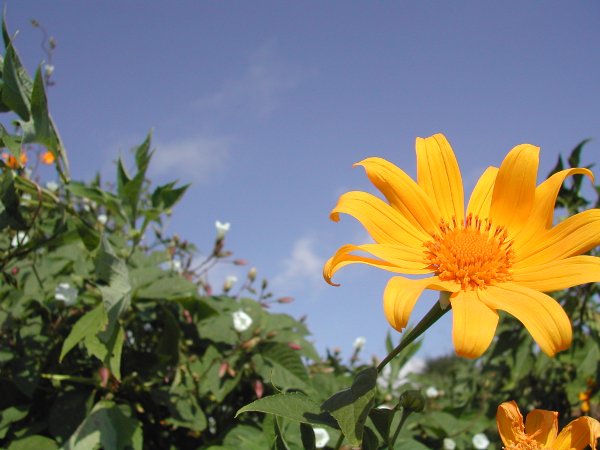Mexican Sunflower
 Common names: Giant Mexican sunflower; shrub sunflower; tree marigold, zhong bing ju, tree marigold, Mexican tournesol, Mexican sunflower, Japanese sunflower or Nitobe chrysanthemum
Common names: Giant Mexican sunflower; shrub sunflower; tree marigold, zhong bing ju, tree marigold, Mexican tournesol, Mexican sunflower, Japanese sunflower or Nitobe chrysanthemum
Scientific name: Tithonia diversifolia
Climate: Temperate
Plant description: It is a herbaceous plant tolerant to acidic and weak soils. It grows 1.5 to 4 meters tall with strong and stable branches. The main root has numerous very fine lateral roots and is characterized by being a wide root network.
The main stem is erect, branched. The tender branches are covered with hairs, which are lost with age.
The leaves grow alternate to each other, they are oval, serrated, and have rounded teeth on the margin; they measure 10 to 40 cm long by 4 to 20 cm wide. They can be simple, or in most cases have 3 to 7 lobes. Have hairs on the upper face and a slightly grayish underside.
The large, showy flowers are yellow to orange in color and are 5 to 15 cm wide and 10 to 30 cm long.
The only seed is an achene 6mm long, dispersed by the wind.
It is native to Mexico and Central America but as an introduced species it is distributed throughout the tropics.
Cultivation: Can be propagated by seeds or cuttings. The seed is sown at a depth of 2 to 3 cm, with a distance of 50 to 75 cm between plants, it needs good drainage. Its vegetative cycle is annual. Moderately tolerant of drought.
Staking young plants is more effective, taking stems measuring 50 cm by 2 to 3.5 cm in diameter and having 3 to 4 buds. They are sown inclined or horizontal without covering them completely, .75 to 1 meter between rows.
It grows from sea level to 3000 meters, with a variety of rainfall regimes.
Acid to neutral and poor to fertile soils. It does not tolerate flooded soils.
It can be invasive and toxic to rice, sorghum, corn, and lettuce crops.
 Uses: Beekeeping, floriculture, as fodder, it is rich in protein, valuable for ruminants and rabbits.
Uses: Beekeeping, floriculture, as fodder, it is rich in protein, valuable for ruminants and rabbits.
As a medicine, it is frequently used to treat skin conditions such as pimples, sores, scabies, and wounds, as, and to relieve itching. It is also used against respiratory diseases such as cough, asthma, and bronchitis. It is also used to treat bumps, fever, cramps, and swelling.
It is used as biomass rich in nutrients (N, K, and P), as well as a recuperator and rejuvenator of soils.
Plagues and diseases: Repels pests and mule ants.
References:
Anjarwalla, P., A. Ofori, D., & Kandungu, J. (2013, January). Tithonia diversifolia. World agroforestry centre. https://www.researchgate.net/publication/262486678_Tithonia_diversifolia
colaboradores de Wikipedia. (2020, June 22). Tithonia diversifolia. Wikipedia, La Enciclopedia Libre. https://es.wikipedia.org/wiki/Tithonia_diversifolia
Tithonia diversifolia - WikiMili, The Free Encyclopedia. (2020, February 18). WikiMili.Com. https://wikimili.com/en/Tithonia_diversifolia
Tithonia diversifolia (Mexican sunflower). (n.d.). CABI. Retrieved August 15, 2020, from https://www.cabi.org/isc/datasheet/54020
Wikipedia contributors. (2020, June 15). Tithonia diversifolia. Wikipedia. https://en.wikipedia.org/wiki/Tithonia_diversifolia
(n.d.). Mexican sunflower (Tithonia diversifolia). Feedipedia. Retrieved August 15, 2020, from https://feedipedia.org/node/15645
En español: Giganton
